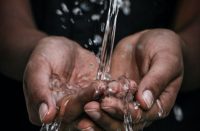IS IT JUST ME or has energy replaced child pop star Justin Bieber as this year’s hot topic? There are advertisements for clean energy on television, signs on the side of the road about wind farms, newspaper headlines describing yet another catastrophic oil spill, and Oprah is asking me to switch to compact fluorescent light bulbs! But amid this energy talk, I’m left wondering why water, energy’s no-less-deserving cousin, rarely makes the news.
IS IT JUST ME or has energy replaced child pop star Justin Bieber as this year’s hot topic? There are advertisements for clean energy on television, signs on the side of the road about wind farms, newspaper headlines describing yet another catastrophic oil spill, and Oprah is asking me to switch to compact fluorescent light bulbs! But amid this energy talk, I’m left wondering why water, energy’s no-less-deserving cousin, rarely makes the news.
Many will recall their high school biology lessons about how energy from sunlight and water are two of life’s essential building blocks. But somewhere between having braces removed and getting that first job, the textbook recipe for all living things faded from most people’s memory.
Our absolute reliance on water and energy is often concealed in the modern world. Yet an examination of our daily needs – from growing and preparing food to powering a laptop and manufacturing automobiles – reveals that we use enormous quantities of energy and water. The interconnection between these life-essentials is not obvious. Water-use represents a significant part of our energy footprint, and consumption of energy has a major impact on our use of this valuable resource.
Water Services are Energy Hogs
Consider the energy needed to move, treat and heat water. In the POLIS Project’s recent study, Ontario’s Water-Energy Nexus: Will We Find Ourselves in Hot Water … or Tap into Opportunity?, we estimate that treating and transporting clean drinking water from its source to homes, businesses and farms in Ontario, requires the same amount of power needed to light each and every house in the province. If we add the energy required to heat water and generate steam for manufacturing and space heating, water-related services consume an estimated 40 per cent of the province’s natural gas and 12 per cent of its electricity.
Energy Services are Water Hogs
The other side of what is now being called the water-energy nexus is the amount of water needed to produce energy. For example, conventional electricity generation almost always requires water. Some is “consumed,” in that it is lost to the environment and some of it is “used,” in that it is part of the industrial process, but is then returned to the environment, oftentimes having been contaminated. The water used to cool nuclear, coal and gas power plants accounts for 63 per cent of Canada’s total water withdrawals – more than six times the water used for homes, industry and agriculture. And these withdrawals are in addition to the vast volumes of water that turn the turbines in Canada’s network of hydro-electric dams, which supply 59 per cent of the nation’s electricity.
Hogwash
Heating buildings, fueling vehicles, manufacturing and food processing also require large quantities of petroleum products. As illuminated by recent oil spills, the environmental impact of fossil fuel use frequently comes in the form of water contamination. The Pembina Institute estimates that Alberta’s licensed oil-sands operations can legally remove a volume of water from the Athabasca River that is equivalent to the amount needed to sustain a city of two million people. Significantly, processing oil sands contaminates much of this water, rendering it too toxic to be released back into the river.
Extracting conventional sources of natural gas is not particularly water intensive. But natural gas is now being removed from unconventional sources, such as coalbed methane and shale. These practices rely on a process called hydraulic fracturing or fracking, which involves injecting a water and chemical mixture to help the extraction process. When shale is located far below the Earth’s surface, fracking consumes millions of litres for a single operation.
Moreover, as Jessica Ernst discovered in Rosebud, Alberta, it can also contaminate groundwater. Ernst has so much ethane, methane and benzene in her tap water that she can light it on fire. A biologist, she alleges that fracking is to blame.
Alternative Energy Hogs
High water-use is not only associated with fossil fuel extraction. A number of renewable fuels can also have significant water footprints. Michael Webber and Carey King at the University of Texas report that a car fueled by ethanol produced from corn grown on irrigated fields is actually consuming about 26 litres of water per kilometre driven. It’s hard to imagine, but a 100-kilometre drive down a lovely country road in such a vehicle is equivalent to flushing your highly efficient toilet 433 times. This unfortunate reality conjures up images of a toilet-propelled car and one very happy toddler who is gleefully pushing the flusher once every eight seconds.
Escaping Hog’s Hollow
But beyond being equipped with some entertaining energy statistics to impress colleagues while hanging out at the water cooler, what do these numbers tell us? I suggest two things: We need to exercise caution and it’s time to seize opportunities.
The highly interconnected nature of water and energy systems poses heightened risks in a warming climate, especially when this nexus is superimposed on a never-ending demand for both resources. Canada’s dependence on river power for electricity, for example, means that we are vulnerable given the expected impacts of climate change. According to the World Wildlife Fund Canada, a two-degree increase in global temperatures could translate into as much as a 17-per-cent decrease in hydropower production on the St. Lawrence River.
Warmer water will further increase water-use in energy production since higher temperatures mean that more cooling water will be required to produce the same amount of power. More cooling water translates into more fuel consumption, and the cascading effect continues. On the other side of the nexus, more energy-intensive approaches may be required to transport clean water over longer distances and from greater depths to satisfy the municipal, commercial and industrial requirements of burgeoning Canadian cities. Unless we rein in demand for both water and energy, increased pressure on these natural resources will translate into skyrocketing costs for government, businesses and ratepayers. Hence the need for caution.
The good news is that it doesn’t have to be this way. When we see that reducing overconsumption and minimizing waste present opportunities, the equation changes. Small and seemingly isolated water and energy savings cascade along the entire water and energy supply chain – making them opportunities worth seizing.
It turns out that while finding new “clean” sources of water and energy may be critical elements of the path to sustainability, they are not equal to conservation. The linked nature of conservation means that reducing water- and energy-use by managing resources more efficiently, and by adapting lifestyles and communities to consume less, is by far the best way to reverse the vicious cycle of the water-energy nexus and achieve sustainability.
Carol Maas, the innovation and technology director with the POLIS Water Sustainability Project, authored a 2010 report entitled, Ontario’s Water-Energy Nexus: Will We Find Ourselves in Hot Water … or Tap into Opportunity? This article is derived from that body of work.
Carol Maas is the innovation and technology director with the POLIS Water Sustainability Project. She takes short showers, launders clothes in the cold stuff and her gardens take no water at all.












